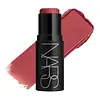What's inside
What's inside
 Key Ingredients
Key Ingredients

 Benefits
Benefits

 Concerns
Concerns

 Ingredients Side-by-side
Ingredients Side-by-side

CI 77891
Cosmetic ColorantDimethicone
EmollientHydrogenated Polyisobutene
EmollientMica
Cosmetic ColorantIsodecyl Neopentanoate
EmollientHydrogenated Polydecene
EmollientPhenyl Trimethicone
Skin ConditioningPolyethylene
AbrasiveEthylhexyl Hydroxystearate
EmollientCI 77491
Cosmetic ColorantCI 77492
Cosmetic ColorantPolymethyl Methacrylate
Silica
AbrasivePolyglyceryl-3 Diisostearate
EmulsifyingBeeswax
Emulsion StabilisingMicrocrystalline Wax
Emulsion StabilisingTribehenin
EmollientAscorbyl Palmitate
AntioxidantBHT
AntioxidantEthylhexyl Palmitate
EmollientParfum
MaskingGlucomannan
Skin ConditioningPhenoxyethanol
PreservativeCI 15850
Cosmetic ColorantSodium Hyaluronate
HumectantTalc
AbrasiveTocopherol
AntioxidantTocopheryl Acetate
AntioxidantTrihydroxystearin
Skin ConditioningCI 77007
Cosmetic ColorantCI 77891, Dimethicone, Hydrogenated Polyisobutene, Mica, Isodecyl Neopentanoate, Hydrogenated Polydecene, Phenyl Trimethicone, Polyethylene, Ethylhexyl Hydroxystearate, CI 77491, CI 77492, Polymethyl Methacrylate, Silica, Polyglyceryl-3 Diisostearate, Beeswax, Microcrystalline Wax, Tribehenin, Ascorbyl Palmitate, BHT, Ethylhexyl Palmitate, Parfum, Glucomannan, Phenoxyethanol, CI 15850, Sodium Hyaluronate, Talc, Tocopherol, Tocopheryl Acetate, Trihydroxystearin, CI 77007
Isodecyl Isononanoate
EmollientSilica
AbrasiveOctyldodecyl Stearoyl Stearate
EmollientSynthetic Wax
AbrasiveIsodecyl Neopentanoate
EmollientC12-15 Alkyl Benzoate
AntimicrobialSynthetic Fluorphlogopite
CI 77120
Cosmetic ColorantIllite
AbrasiveLimnanthes Alba Seed Oil
Skin ConditioningSorbitan Isostearate
EmulsifyingSorbitan Sesquioleate
EmulsifyingStearalkonium Hectorite
Gel FormingPrunus Persica Kernel Oil
EmollientEthylhexylglycerin
Skin ConditioningTocopherol
AntioxidantRheum Palmatum Root Extract
AstringentMica
Cosmetic ColorantTocopheryl Acetate
AntioxidantIsopropyl Titanium Triisostearate
EmollientAluminum Hydroxide
EmollientTriethoxycaprylylsilane
Tin Oxide
AbrasiveWater
Skin ConditioningButylene Glycol
HumectantPhenoxyethanol
PreservativeCI 16035
Cosmetic ColorantCI 77891
Cosmetic ColorantCI 77491
Cosmetic ColorantCI 42090
Cosmetic ColorantCI 19140
Cosmetic ColorantIsodecyl Isononanoate, Silica, Octyldodecyl Stearoyl Stearate, Synthetic Wax, Isodecyl Neopentanoate, C12-15 Alkyl Benzoate, Synthetic Fluorphlogopite, CI 77120, Illite, Limnanthes Alba Seed Oil, Sorbitan Isostearate, Sorbitan Sesquioleate, Stearalkonium Hectorite, Prunus Persica Kernel Oil, Ethylhexylglycerin, Tocopherol, Rheum Palmatum Root Extract, Mica, Tocopheryl Acetate, Isopropyl Titanium Triisostearate, Aluminum Hydroxide, Triethoxycaprylylsilane, Tin Oxide, Water, Butylene Glycol, Phenoxyethanol, CI 16035, CI 77891, CI 77491, CI 42090, CI 19140
Ingredients Explained
These ingredients are found in both products.
Ingredients higher up in an ingredient list are typically present in a larger amount.
Ci 77491 is also hydrated iron III oxide. It's sole purpose is to give a red/pink hue to products.
Iron III oxides are classified as inorganic chemicals for coloring.
Synthetically created Ci 77491 is considered safer than those naturally found. This is because the synthetically created version may contain less impurities. Iron oxides are generally non-toxic and non-allergenic.
Learn more about CI 77491Ci 77891 is a white pigment from Titanium dioxide. It is naturally found in minerals such as rutile and ilmenite.
It's main function is to add a white color to cosmetics. It can also be mixed with other colors to create different shades.
Ci 77891 is commonly found in sunscreens due to its ability to block UV rays.
Learn more about CI 77891We don't have a description for Isodecyl Neopentanoate yet.
Mica is a naturally occurring mineral used to add shimmer and color in cosmetics. It can also help improve the texture of a product or give it an opaque, white/silver color.
Serecite is the name for very fine but ragged grains of mica.
This ingredient is often coated with metal oxides like titanium dioxide. Trace amounts of heavy metals may be found in mica, but these metals are not harmful in our personal products.
Mica has been used since prehistoric times throughout the world. Ancient Egyptian, Indian, Greek, Roman, Aztec, and Chinese civilizations have used mica.
Learn more about MicaPhenoxyethanol is a preservative that has germicide, antimicrobial, and aromatic properties. Studies show that phenoxyethanol can prevent microbial growth. By itself, it has a scent that is similar to that of a rose.
It's often used in formulations along with Caprylyl Glycol to preserve the shelf life of products.
Silica, also known as silicon dioxide, is a naturally occurring mineral. It is used as a fine, spherical, and porous powder in cosmetics.
Though it has exfoliant properties, the function of silica varies depending on the product.
The unique structure of silica enhances the spreadability and adds smoothness, making it a great texture enhancer.
It is also used as an active carrier, emulsifier, and mattifier due to its ability to absorb excess oil.
In some products, tiny microneedles called spicules are made from silica or hydrolyzed sponge. When you rub them in, they lightly polish away dead skin layers and enhance the penetration of active ingredients.
Learn more about SilicaTocopherol (also known as Vitamin E) is a common antioxidant used to help protect the skin from free-radicals and strengthen the skin barrier. It's also fat soluble - this means our skin is great at absorbing it.
Vitamin E also helps keep your natural skin lipids healthy. Your lipid skin barrier naturally consists of lipids, ceramides, and fatty acids. Vitamin E offers extra protection for your skin’s lipid barrier, keeping your skin healthy and nourished.
Another benefit is a bit of UV protection. Vitamin E helps reduce the damage caused by UVB rays. (It should not replace your sunscreen). Combining it with Vitamin C can decrease sunburned cells and hyperpigmentation after UV exposure.
You might have noticed Vitamin E + C often paired together. This is because it is great at stabilizing Vitamin C. Using the two together helps increase the effectiveness of both ingredients.
There are often claims that Vitamin E can reduce/prevent scarring, but these claims haven't been confirmed by scientific research.
Learn more about TocopherolTocopheryl Acetate is AKA Vitamin E. It is an antioxidant and protects your skin from free radicals. Free radicals damage the skin by breaking down collagen.
One study found using Tocopheryl Acetate with Vitamin C decreased the number of sunburned cells.
Tocopheryl Acetate is commonly found in both skincare and dietary supplements.
Learn more about Tocopheryl Acetate